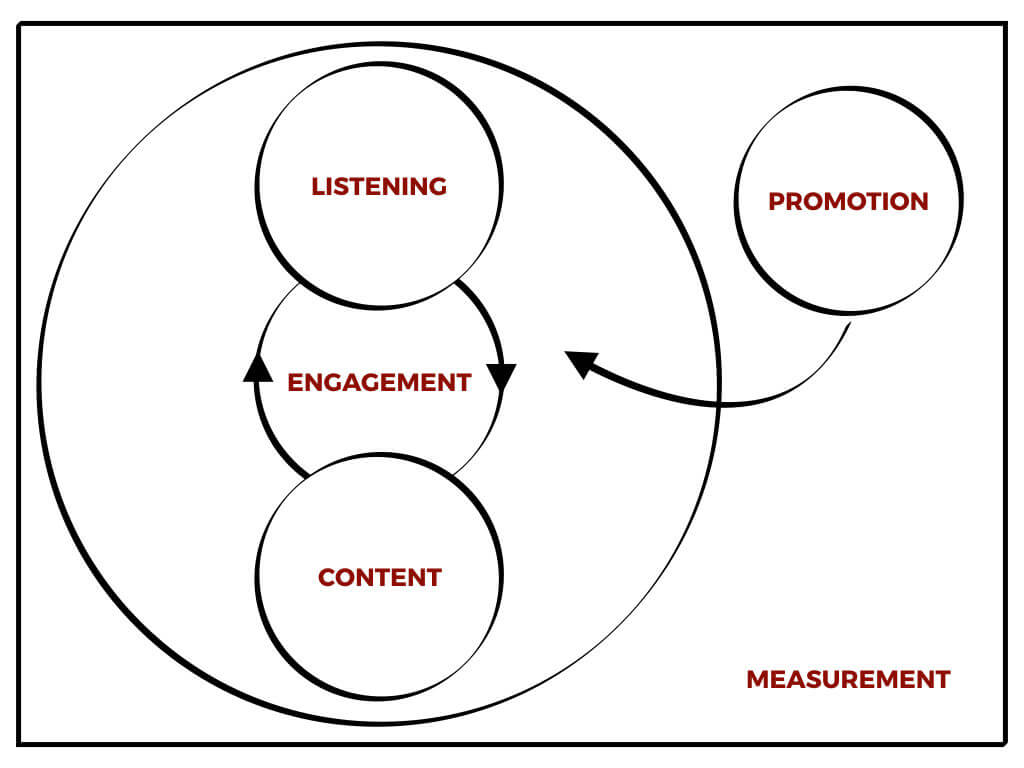The elements that combine to form social media are not just platforms, like Facebook or Linkedin. While Social Media is a term that is used commonly used to mean “anything found on Facebook, Twitter, or Instagram,” there are more useful ways of seeing Social Media.
For the sake of reaching a deeper understanding, let’s instead look at social media in terms of the activities that make social media tools particularly useful.
The Five Key Elements of Social Media

In this framework, Social media are a collection of technologies that enable people to, listen, create, share, connect, amplify and measure media (content) with one another. This all generally happens in an environment free from the constraints of gatekeepers or approval processes, and by definition on platforms that require two-way and multi-way communications.
As a result, five inter-related elements of social media have become available.
- Listening (Research)
- Content Marketing (Content Creation and Curation)
- Engagement (Community Management)
- Promotion (Advertising)
- Measurement (Metrics, KPIs, and Analytics)
If we think of social media through this lens, we can more clearly assess each site.
A proper social media marketing mix will involve all five of these elements.
The Five Key Elements: A Brief Explanation
Listening
Listening refers to the process of searching and monitoring public conversations and shared content for mentions of brands, products, services, questions, or other keywords with the intention of identifying and understanding trends.
Some software has automatic sentiment tracking, which uses artificial intelligence to interpret whether the emotion tied to the social result is positive, negative or neutral. Beyond that most other professional listening software can compare the volume of search results for two organizations against one another to determine their respective “share of voice.” They also may provide trend analysis to show emerging and popular conversations.
Listening can also be done manually by examining the news feeds of various sites or individuals to uncover valuable intelligence based on what they share.
Content Marketing
Content marketing is the use of media, such as written text, pictures, videos, slideshows and more, to earn attention and traffic with the intent to position a company or individual as knowledgeable and trusted, and to generate new prospects and customers.
Content marketing is most successful when focused on providing valuable information to the target audience.
Content can either be created or curated (collected and organized from around the web).
Engagement
Engagement is the process of directly connecting with another individual, and using a mixture of listening, content marketing and conversation skills to build trust and loyalty by solving problems and providing value.
Hallmark traits of effective and engaged community management are empathy, compassion, and responsive communication.
Promotion & Advertising
Promotion is intended to describe any activities, typically paid, that amplify content or solicit feedback or response about a product, service, website or marketplace.
Promotion can involve offline activities such as business cards or posters, or online activities such as display advertisements, social media ads, paid search campaigns, influencer marketing, or experiential marketing, to name a few.
Measurement & Analytics
Measurement and analytics covers all activities related to the capture and analysis of data. This can include user demographic or interest data, website traffic and behavior, interactions and impressions for advertisements, and any other activity that generates data.
Measurement and analytics should be applied to all of the other four components of social media in order to understand and improve the effectiveness of each activity.
How to use the five elements of social media
OK, so now you have a new framework… so what?
Once you understand that these five elements of social media are the only five options available, you can begin to incorporate each element into your strategy to the degree that it can help you accomplish your business goal.
For example, let’s assume you have a customer service problem. Which of these elements of social media might you use to identify the problem, and then communicate actions taken to rectify the issue? My suggestion is that you start by investing in social listening.
- Spend time getting to understand your customers better so that you may serve them better.
- Analyze for trends in their feedback.
- Look for how your competition is attempting to capitalize on it.
Once you’ve gathered enough information, make changes, and communicate those changes using content, which you amplify to your customers, and prospects using promotion. Watch for comments on your ads, or on your organic posts. When people offer additional comments or feedback, engage them in conversation. Get closer to these clients. Nurture the relationship.
Now, by contrast, let’s say you were launching a brand new product in a brand new product category. While listening is still important (hint: it’s always important), your critical path is heavily dependent on content and promotion. In a new market, there is less to listen for. When you put out content, no one knows who you are, there’s no built in audience, hence there’s no engagement. So, you must promote your content. As you do this, frequently look at your measurements. Figure out what is work, and what is not.
Part of a set of frameworks
As I mentioned in the post Proven Social Media Strategies, I am going to share some of what I’ve learned over the last decade in this business, and give you practical information to grow your business. If you haven’t subscribed yet, do it. And if you’ve forgotten what topics I’ll be covering, go to the Proven Social Media Strategies post for the list of topics.
